The preservation of favoured traces
We often think of scientific ideas, such as Darwin's theory of evolution, as fixed notions that are accepted as finished. In fact, Darwin's On the Origin of Species evolved over the course of several editions he wrote, edited, and updated during his lifetime. The first English edition was approximately 150,000 words and the sixth is a much larger 190,000 words. In the changes are refinements and shifts in ideas — whether increasing the weight of a statement, adding details, or even a change in the idea itself. The second edition, for instance, adds a notable “by the Creator” to the closing paragraph, giving greater attribution to a higher power. This project is made possible by the hard work of Dr.
NodeXL Image in NewScientist: Paper trail: Inside the stem cell wars
June 9th, 2010 by Marc Smith · 4 Comments The June 9 issue of New Scientist contains an article featuring a map of scientific citation that was generated by NodeXL. The article about the patterns of citation and the time to publication for US and non-US based scientists contains a map of which papers and authors cite which other papers and authors. From New Scientist: Our analysis of more than 200 research papers from 2006 onwards reveals that US-based scientists are enjoying a significant advantage, getting their papers published faster and in more prominent journals (find our data, methods and analyses here). Description of the methods used to generate the image is available here. “To map the network of citations, we imported the data into a Microsoft Excel spreadsheet running a social-network analysis extension called NodeXL. There were 43 scientists in the network, 24 from the US and 19 from elsewhere.
How We Visualized America’s Food and Drink Spending on Datavisualization
One of our favorite things about data visualization is that every single project comes with interesting people, a whole new context and a different story to tell. Recently, we had the chance to meet the people from the Bundle headquarter, to dive into a bunch of interesting data about food and drink spending in America and to develop an exciting infographic. Now we would like to let you take a glimpse behind the scenes. The Story You know it’s hard to track all your spending and to be in full control of your personal budget — even harder in busy times. Not everyone is as disciplined as Nicholas Felton and keeps every single receipt of a Starbucks coffee. After a full year of collecting and providing data, Bundle engaged different designers to participate and create a series of reports to summarize America’s total spending. The Creation The “Food & Drink“ category is composed of spending both on dining out as well as groceries. Below is one of the first drafts made in Illustrator.
amfAR Annual Report on Datavisualization
For their annual report the amfAR, the foundation for innovative AIDS Research published a world map displaying the breadth of their activities during 2008. The visualization maps all the grants, fellowships and awards of the fiscal year 2008. The projects are represented as dots color coded by the program areas Research, MSM Initiative, Treat Asia and Advocacy & Outreach. Clicking on a dot opens up a detailed view on the project showing a description, context and place. The visualization was created by Kelli Anderson using Flash and a static dataset about the activities of amfAR. While the interaction model is reduced in functionality and the complexity of data is rather low, the visualization gives quick access to project information nonetheless.
The State of Information Visualization, 2011
Theory in visualization! Swivel disappears! Reappears! Disappears again! 2010: What Was I called 2010 the year of InfoVis theory, and I wasn’t too far off. Another big theme at VisWeek 2010 was storytelling in visualization. Last year also saw the disappearance of Swivel, its brief reappearance, and finally(?) WikiLeaks made a big splash last year (and continues to make headlines) with its release of U.S. diplomatic cables and documents from Afghanistan and Iraq. But secondly, I’m afraid that WikiLeaks has caused much greater skepticism on the part of governments to open their data. 2011: What Will Be I see a few trends become stronger and more pronounced in 2011. In particular, I think we are ready for truly interactive, browser-based visualization. But another development will actually be much more important: Internet Explorer 9. The hope is that IE 9 will be adopted quickly, finally removing the last excuses not to unleash the power of HTML5 on the web. Beyond 2011: What Is to Come
Related:
Related:



